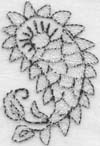Section 7 == *script chart*; *positional chart*; *more help*
The letter fe , "f," consists, in theory, of a head like that of vāʾo with one dot above it, combined with a body like that of the be series. In initial and medial forms, the head alone is retained. Since "f" was imported from Persian, it is shown in Devanagari by a "pha" with a dot below it.
The letter qāf is one for which we have no counterpart in English; using "q" to designate it is just a convenience. In Platts's classic definition it is "a strongly articulated guttural, uttered by pressing the root of the tongue on the throat, and has been compared in sound to the caw of a raven." In my experience it is the hardest sound for us English-speakers to master. But many Urdu-speakers nowadays, especially those influenced by Panjabi, pronounce qāf as identical to kāf . This however is considered less elegant, and also leads to increased spelling problems.
In form, qāf consists of a head like that of vāʾo with two dots above, combined with a body like that of nūn . Note that fe and qāf are identical in shape in initial and medial forms, but not in final and independent forms. Since qāf is not an Indic sound, it is shown in Devanagari as a "ka" with a dot under it.
The letter mīm , "m," loses its long tail in its initial and medial forms, and is reduced to its tiny dotless head, a loop so small that is sometimes barely visible. But since no other letter has a loop without a dot, it can in principle be recognized, no matter how tiny.
The letter ʿain is, in Arabic, a "pharyngeal voiced fricative representing the effort made by the throat in pronouncing a vowel at the beginning of a word or a syllable," as Zakir puts it. Fortunately (or unfortunately, depending on whether you're thinking of pronunciation or spelling) for us Urdu speakers, it has evolved in Urdu into a kind of "wild-card" vowel sound instead: it can provide a variety of different short and long vowel sounds, according to the needs of the particular word. It is present only in certain Arabic words-- but in them it is compulsory, of course, and must be learned along with the spelling.
Here are some familiar words that contain it, and illustrate its variety: maʿlūm (known), ʿaurat (woman), ke baʿd (after), ʿishq (love), aʿlān (announcement); shiʿr (verse); in the word shurūʿ (open), it can't be heard at all.
The letter ʿain has four quite different forms: its independent one, which somewhat resembles a backwards 3; the initial, which is the top loop of the backwards 3 only; the medial, which is (for no particular reason that I can see) a tiny inverted triangle; and the final, which is the triangle plus the bottom loop of the backwards 3. Since it can be pronounced in so many different ways, there is no one special way to represent it in Devanagari.
The letter ġhain , a "velarised voiced fricative," is, like qāf , one for which we have no equivalent in English. If you start with a kind of low growl in the throat, it is easy to learn to make it. It occurs only in certain Arabic words, and in them it is of course compulsory.
In form, it exactly resembles ʿain , but with a dot above it. In Devanagari, it is represented as a "ga" with a dot under it. It might be more accurate to use a "gha" with a dot under it, but the convention of using the "ga" is already firmly fixed.
